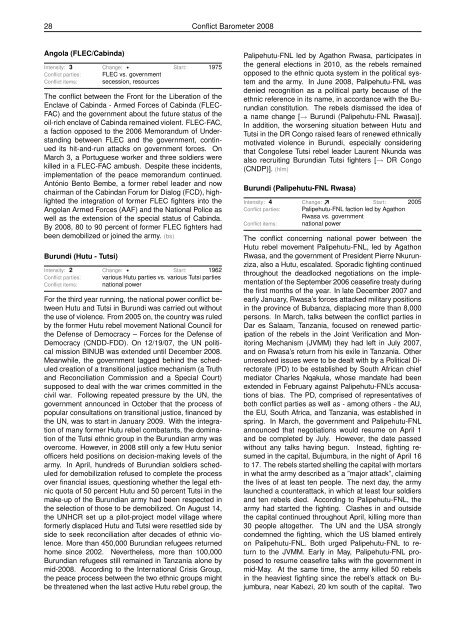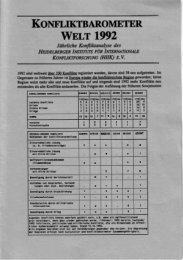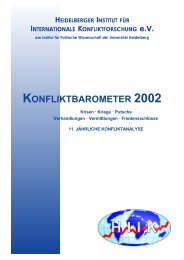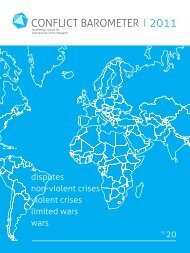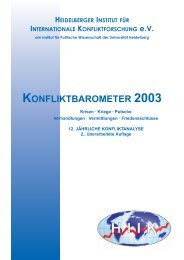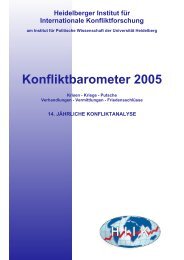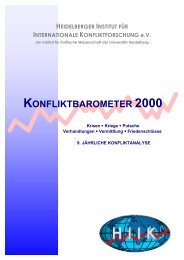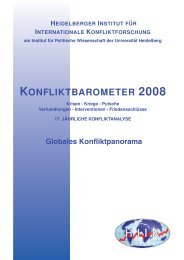CONFLICT BAROMETER 2008
CONFLICT BAROMETER 2008
CONFLICT BAROMETER 2008
Create successful ePaper yourself
Turn your PDF publications into a flip-book with our unique Google optimized e-Paper software.
28 Conflict Barometer <strong>2008</strong><br />
Angola (FLEC/Cabinda)<br />
Intensity: 3 Change: Start: 1975<br />
Conflict parties: FLEC vs. government<br />
Conflict items: secession, resources<br />
The conflict between the Front for the Liberation of the<br />
Enclave of Cabinda - Armed Forces of Cabinda (FLEC-<br />
FAC) and the government about the future status of the<br />
oil-rich enclave of Cabinda remained violent. FLEC-FAC,<br />
a faction opposed to the 2006 Memorandum of Understanding<br />
between FLEC and the government, continued<br />
its hit-and-run attacks on government forces. On<br />
March 3, a Portuguese worker and three soldiers were<br />
killed in a FLEC-FAC ambush. Despite these incidents,<br />
implementation of the peace memorandum continued.<br />
António Bento Bembe, a former rebel leader and now<br />
chairman of the Cabindan Forum for Dialog (FCD), highlighted<br />
the integration of former FLEC fighters into the<br />
Angolan Armed Forces (AAF) and the National Police as<br />
well as the extension of the special status of Cabinda.<br />
By <strong>2008</strong>, 80 to 90 percent of former FLEC fighters had<br />
been demobilized or joined the army. (bs)<br />
Burundi (Hutu - Tutsi)<br />
Intensity: 2 Change: Start: 1962<br />
Conflict parties: various Hutu parties vs. various Tutsi parties<br />
Conflict items: national power<br />
For the third year running, the national power conflict between<br />
Hutu and Tutsi in Burundi was carried out without<br />
the use of violence. From 2005 on, the country was ruled<br />
by the former Hutu rebel movement National Council for<br />
the Defense of Democracy – Forces for the Defense of<br />
Democracy (CNDD-FDD). On 12/19/07, the UN political<br />
mission BINUB was extended until December <strong>2008</strong>.<br />
Meanwhile, the government lagged behind the scheduled<br />
creation of a transitional justice mechanism (a Truth<br />
and Reconciliation Commission and a Special Court)<br />
supposed to deal with the war crimes committed in the<br />
civil war. Following repeated pressure by the UN, the<br />
government announced in October that the process of<br />
popular consultations on transitional justice, financed by<br />
the UN, was to start in January 2009. With the integration<br />
of many former Hutu rebel combatants, the domination<br />
of the Tutsi ethnic group in the Burundian army was<br />
overcome. However, in <strong>2008</strong> still only a few Hutu senior<br />
officers held positions on decision-making levels of the<br />
army. In April, hundreds of Burundian soldiers scheduled<br />
for demobilization refused to complete the process<br />
over financial issues, questioning whether the legal ethnic<br />
quota of 50 percent Hutu and 50 percent Tutsi in the<br />
make-up of the Burundian army had been respected in<br />
the selection of those to be demobilized. On August 14,<br />
the UNHCR set up a pilot-project model village where<br />
formerly displaced Hutu and Tutsi were resettled side by<br />
side to seek reconciliation after decades of ethnic violence.<br />
More than 450,000 Burundian refugees returned<br />
home since 2002. Nevertheless, more than 100,000<br />
Burundian refugees still remained in Tanzania alone by<br />
mid-<strong>2008</strong>. According to the International Crisis Group,<br />
the peace process between the two ethnic groups might<br />
be threatened when the last active Hutu rebel group, the<br />
Palipehutu-FNL led by Agathon Rwasa, participates in<br />
the general elections in 2010, as the rebels remained<br />
opposed to the ethnic quota system in the political system<br />
and the army. In June <strong>2008</strong>, Palipehutu-FNL was<br />
denied recognition as a political party because of the<br />
ethnic reference in its name, in accordance with the Burundian<br />
constitution. The rebels dismissed the idea of<br />
a name change [→ Burundi (Palipehutu-FNL Rwasa)].<br />
In addition, the worsening situation between Hutu and<br />
Tutsi in the DR Congo raised fears of renewed ethnically<br />
motivated violence in Burundi, especially considering<br />
that Congolese Tutsi rebel leader Laurent Nkunda was<br />
also recruiting Burundian Tutsi fighters [→ DR Congo<br />
(CNDP)]. (hlm)<br />
Burundi (Palipehutu-FNL Rwasa)<br />
Intensity: 4 Change: Start: 2005<br />
Conflict parties: Palipehutu-FNL faction led by Agathon<br />
Rwasa vs. government<br />
Conflict items: national power<br />
The conflict concerning national power between the<br />
Hutu rebel movement Palipehutu-FNL, led by Agathon<br />
Rwasa, and the government of President Pierre Nkurunziza,<br />
also a Hutu, escalated. Sporadic fighting continued<br />
throughout the deadlocked negotiations on the implementation<br />
of the September 2006 ceasefire treaty during<br />
the first months of the year. In late December 2007 and<br />
early January, Rwasa’s forces attacked military positions<br />
in the province of Bubanza, displacing more than 8,000<br />
persons. In March, talks between the conflict parties in<br />
Dar es Salaam, Tanzania, focused on renewed participation<br />
of the rebels in the Joint Verification and Monitoring<br />
Mechanism (JVMM) they had left in July 2007,<br />
and on Rwasa’s return from his exile in Tanzania. Other<br />
unresolved issues were to be dealt with by a Political Directorate<br />
(PD) to be established by South African chief<br />
mediator Charles Nqakula, whose mandate had been<br />
extended in February against Palipehutu-FNL’s accusations<br />
of bias. The PD, comprised of representatives of<br />
both conflict parties as well as - among others - the AU,<br />
the EU, South Africa, and Tanzania, was established in<br />
spring. In March, the government and Palipehutu-FNL<br />
announced that negotiations would resume on April 1<br />
and be completed by July. However, the date passed<br />
without any talks having begun. Instead, fighting resumed<br />
in the capital, Bujumbura, in the night of April 16<br />
to 17. The rebels started shelling the capital with mortars<br />
in what the army described as a ”major attack”, claiming<br />
the lives of at least ten people. The next day, the army<br />
launched a counterattack, in which at least four soldiers<br />
and ten rebels died. According to Palipehutu-FNL, the<br />
army had started the fighting. Clashes in and outside<br />
the capital continued throughout April, killing more than<br />
30 people altogether. The UN and the USA strongly<br />
condemned the fighting, which the US blamed entirely<br />
on Palipehutu-FNL. Both urged Palipehutu-FNL to return<br />
to the JVMM. Early in May, Palipehutu-FNL proposed<br />
to resume ceasefire talks with the government in<br />
mid-May. At the same time, the army killed 50 rebels<br />
in the heaviest fighting since the rebel’s attack on Bujumbura,<br />
near Kabezi, 20 km south of the capital. Two


